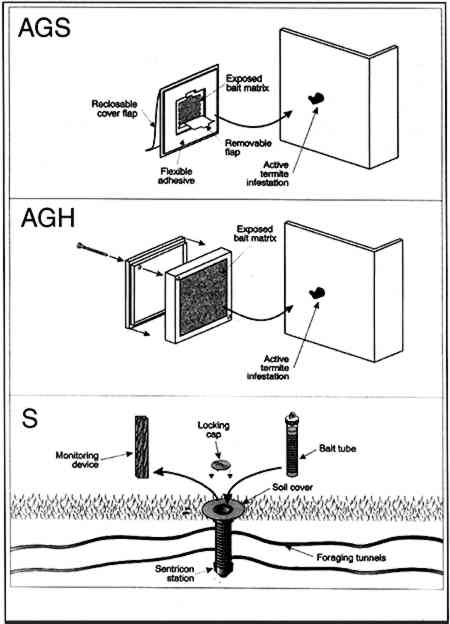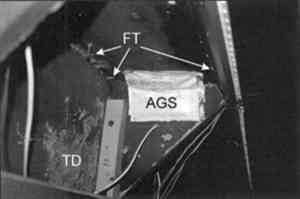ELIMINATION OF SUBTERRANEAN TERMITE POPULATIONS FROM THE STATUE OF LIBERTY NATIONAL MONUMENT USING A BAIT MATRIX CONTAINING AN INSECT GROWTH REGULATOR, HEXAFLUMURONNAN-YAO SU, JAMEY D. THOMAS, & RUDOLF H. SCHEFFRAHN
4 BAIT STATIONS4.1 ABOVE-GROUND BAIT STATIONSTwo types of above-ground bait stations—soft-style (Recruit AG) and hard-style (Dow AgroSciences)—were used to deliver hexaflumuron to termite populations. 4.1.1 Soft-Style Above-Ground Bait Station (AGS)The soft-style station consisted of a flexible laminated pouch (15 � 15 � 0.5 cm) containing 15 g of 0.5% hexaflumuron. On the front side of the station was a reclosable cover flap, and on the backside was a removable flap (7 � 7 cm) surrounded by a 3.5 cm-wide collar of flexible adhesive (fig. 2). In the presence of an active infestation, the removable flap was pulled to expose the bait matrix. The exposed bait matrix was moistened with 30–40 cc water and then attached over an active infestation using the flexible adhesive so that it was accessible to foraging termites. Because of its flexibility, the soft-style station was adaptable to flat, curved, or contoured surfaces (fig. 3, p. 287). The station was inspected monthly or bimonthly. When bait was substantially consumed, the reclosable outer cover flap was removed, and another soft station was stacked over the old station so that additional bait was available to termites.
4.1.2 Hard-Style Above-Ground Bait Station (AGH)The hard-style above-ground station consisted of a plastic box (10 � 10 � 4 cm) containing 25 g of bait matrix impregnated with 0.5% hexaflumuron. One side of the box was laid open to expose the bait matrix, and the other side was protected by a removable cover (see fig. 2). The exposed bait matrix was moistened with 30–40 cc water and then attached over an active infestation using hot glue so that the exposed bait was accessible to foraging termites. Because more bait can be applied using the hard station than the soft station, AGH was used wherever it could be properly installed, i.e., on a flat surface. The station was inspected monthly or bimonthly by removing the front cover. When needed, another bait box was stacked over the old station so that additional bait was available to termites. 4.2 IN-GROUND SENTRICON STATION (S)The in-ground (Sentricon) station consisted of a plastic tube (4 cm inner diameter � 24 cm long) with one open end and one conical end (see fig. 2) (Su et al. 1995). Four columns of 11 rectangular holes each (3 � 1 cm) were provided along the entire surface of the tube. A soil cover made of a plastic ring (15 cm diameter with a 7.5 cm diameter inner hole and 1 cm thick) was affixed to the open end of the housing, and a locking top cap (7 cm diameter) was screwed to cover the opening. A hole (5 cm diameter � 25 cm deep) was first drilled into the soil using a gasoline-powered auger. The station was inserted into the hole with the soil cover extending on the soil surface. A monitoring device (two wooden slats, 1.4 � 2.8 � 21 cm) was placed in the station before the locking top cap was attached (see fig. 2, S). Stations were inspected monthly or bimontly to examine termite activity. When termites were found in the station, the monitoring device was replaced by a plastic tube (3.8 cm diameter by 21 cm long) containing 20 g bait matrix (0.5 % hexaflumuron). Bait tubes that were substantially consumed by termites (>50% by visual estimate) were replaced with new tubes. At the conclusion of bait application when termite activity ceased, all bait stations were removed. The partially consumed baits were cleaned of soil debris, dried at 60�C for 48 hours, and cooled in a desiccator before reweighing to determine bait consumption by termites. |

